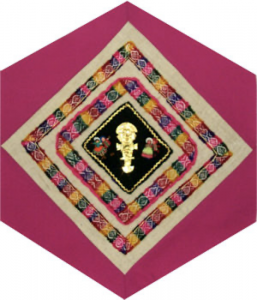Peru

The Block
A thin, golden, metal tumi holds a place of honour at the centre of the Peru block, designed and created by Rosa Maria Luza. Once used as a ceremonial and ritual knife by ancient cultures, it has now become a Peruvian icon. On either side of the tumi, a pair of hand-made, three dimensional miniature dancers, dressed in colourful costumes, have been attached. Music and dancing are important parts of Peruvian life as evidenced by the numerous festivals they celebrate each year. A double band of woven, multi-coloured, woolen braid frames the knife. The bright colours used, which include a vibrant, dark pink known as ‘Peruvian Pink,’ reflect the joy of life that so many Peruvians feel.
Cultural Profile
Peru, located on the west coast of South America, is a land of many wonders: the world’s highest navigable body of water, Lake Titicaca; the ruins of Machu Picchu, constructed of stones that fit together without mortar and have withstood earthquakes; and the Nazca lines, huge drawings on land that pre-date airplanes, yet can only be seen from the air. The country has fascinated the Western world ever since the first Europeans first sighted the land in 1526. Peru is divided into three regions: a dry coastal area to the west, the sierra, snow-capped Andes mountains, and the selva, the Amazonian jungle in the east.
Mestizos, descendants of Amerindians and Europeans, make up 45% of the Peru’s population. A third of the inhabitants are indigenous, therefore their traditions, language and culture occupy a large place in Peruvian culture. Quechuas and Aymaras are the largest native groups, in addition to the approximately 100 other indigenous groups living in the eastern rain forests. These tribes speak traditional languages although Spanish, Quechua, and Aymará are the official languages.
Peruvians love to share their regional cuisine. As a display of their hospitality and warmth, they typically offer a variety of wonderful dishes to visitors. Music and dance are very popular and fiestas (festivals) are held regularly in many communities.
Known for painted gourds, leatherwork, wood carvings and filigree silverware, Peru also has a very old and extensive textile tradition. Indeed, fragments of textiles woven in 8,000 BC out of agave plant fibers were found at the Guitarrero Cave in the Andes. The ancient civilization of Norte Chico wove cotton and wool fabric as early as 2,500 BC. At the arrival of Spanish, Peru was the center of the vast Inca Empire. Among all the crafts, the Incas were most renowned for their weaving. Under Inca rule, textiles were culturally and economically more valuable than gold or silver. Wool and cotton were hand spun using a drop spindle and then dyed with vivid natural pigments, a process which has changed little since then. The most accomplished weavers were always women. Back strap looms, horizontal single-heddle looms and vertical looms were all used, depending on the width of the cloth weavers wished to obtain. The soft vicuna wool was the most prestigious material used, and reserved only to the nobility.
Many indigenous groups still retain their textile traditions. Shipibo-Conibo textiles are easily recognized by their colourful, intricate geometric embroidery. The Shipibo people say their designs are a reflection of the heavenly world made visible through the hands of embroiderers. The large Quechua group of indigenous peoples, which the Inca were part of, still retain their complex weaving traditions today, making trilbies ( knitted caps of felt or straw) and vividly coloured blankets and clothing. On Taquile Island, in Lake Titicaca, men are in charge of knitting, while women spin, dye and weave wool. Their wide woven chumpi belts feature motifs depicting the annual cycles connected to ritual and agricultural activities. This division of labour has endured for centuries.
Peruvians have integrated well into the Canadian fabric. Many of the approximately 34,000 now living in Toronto, Montreal and Vancouver, are actively involved in cultural activities within their communities.
Sponsor: Rita and George St. Pierre
